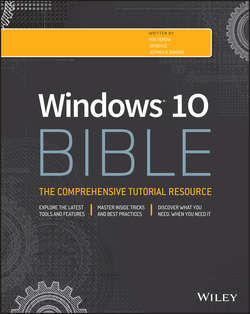Читать книгу Windows 10 Bible - Shapiro Jeffrey R. - Страница 30
На сайте Литреса книга снята с продажи.
Part I
Getting Started
Chapter 3
Getting around the Windows Desktop
Wrapping Up
ОглавлениеThat about wraps up the main terminology and basic skills. Much of what you've learned in this chapter is the kind of stuff most people assume you already know. You may have to read the chapter a few times and practice the skills before it all sinks in. Use the Windows Help for more information and for hands-on practice.
Here's a quick summary of the most important points covered in this chapter:
● The Windows desktop is the primary place you'll do your work.
● Unless you have a touchscreen device (such as a mobile phone or tablet), you'll use your mouse and keyboard to operate the computer.
● Most of your work will involve opening and using programs and apps.
● You can start any program that's installed on your computer from the Start menu.
● Each open program appears in its own program window on the desktop. Program windows stack up like sheets of paper.
● Each open program window has a corresponding taskbar button. The taskbar buttons help you switch from one open program window to another.
● You can move and size program windows to see exactly what you need to see, when you need to see it.
● You can create multiple virtual desktops to organize your running apps.
● When you finish using your computer and want to shut it down, don't reach for the main power switch. Instead, click the Start menu, choose Power, and then click Shut Down.
That's enough for now about the desktop and programs. These days, with just about everyone using a computer to access the Internet, security is a major issue. So, we begin to address that topic in Chapter 4 with a discussion of user accounts and how they relate to computer security.
